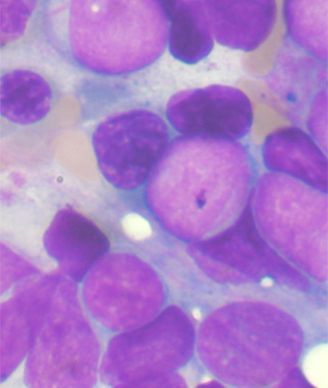Gemtuzumab Then Chemo Offers No Benefit in Elderly AML Patients
The sequential combination of gemtuzumab ozogamicin and standard chemotherapy offered no benefit in older patients with AML, and led to significant toxicities in those aged at least 70 years, according to results of a new study.
Bone marrow aspirate showing acute myeloid leukemia; source: Tontoni, Wikimedia Commons

The sequential combination of gemtuzumab ozogamicin and standard chemotherapy offered no benefit in older patients with acute myeloid leukemia (AML), and led to significant toxicities in those aged at least 70 years, according to results of a new study published online before print in October in the Journal of Clinical Oncology.
The study authors, led by Sergio Amadori, MD, of Vergata University Hospital in Rome, wrote that AML in older patients continues to be challenging, with cure rates below 10%. “This dismal outcome has been attributed to a combination of patient- (eg, comorbidities) and disease-related factors (eg, multi-drug resistance, poor-risk cytogenetics, prior myelodysplasia,” they wrote. The use of gemtuzumab ozogamicin (Mylotarg) has been shown to be effective in some patients; the immunoconjugate drug consists of a humanized anti-CD33 monoclonal antibody linked to an antitumor antibiotic. A previous trial testing gemtuzumab as an induction therapy followed by chemotherapy showed good response, but high toxicity; thus, the current trial lowered the dose and compared the combination with chemotherapy alone.
A total of 472 patients were randomized, with 236 in each group included in an efficacy analysis and the 230 in each that actually received the allocated therapy in a safety analysis. One group received two upfront doses of gemtuzumab 6 mg/m2 on days 1 and 15, followed by a course of mitoxantrone, etoposide, and cytarabine, while the other group received just the chemotherapy regimen as induction therapy. All patients were aged 61 to 75 years and had newly diagnosed AML.
The overall response rate was similar between the groups at 45% for gemtuzumab and 49% for chemotherapy alone. However, induction (17% vs 12%) and 60-day mortality rates (22% vs 18%) were higher in the gemtuzumab arm. After a median follow-up period of 5.2 years, the median overall survival was 7.1 months for gemtuzumab patients and 10 months for chemotherapy alone patients, for a hazard ratio with the study drug of 1.20 (95% CI, 0.99-1.45; P = 0.07).
In patients at least 70 years old, induction death occurred in 26% of gemtuzumab patients and 16% of chemotherapy-alone patients; 60-day mortality rates were 33% and 21%, respectively. A survival was seen with gemtuzumab, however, among the younger patients with secondary AML (HR, 0.57; P = 0.02).
The most common adverse events of grade 3 or worse included infections, febrile neutropenia, GI toxicity, organ dysfunction, and bleeding. There was a slightly higher rate of serious liver toxicity during gemtuzumab therapy, and two patients died of veno-occlusive disease. Infection was the leading cause of mortality resulting from toxicity, at 66% and 85% of the deaths in the gemtuzumab and chemotherapy-alone arms, respectively.
“An intensification strategy combining two upfront doses of [gemtuzumab ozogamicin] 6 mg/m2 with sequential chemotherapy does not benefit older patients with AML and is too toxic for those ≥ 70 years,” the authors concluded. They noted, however, that other recent studies suggest lower doses of the drug given concomitantly with chemotherapy has shown promise. “Lower doses of [gemtuzumab ozogamicin] as an adjunct to standard chemotherapy may offer better outcomes for these patients with limited alternatives.”
Highlighting Insights From the Marginal Zone Lymphoma Workshop
Clinicians outline the significance of the MZL Workshop, where a gathering of international experts in the field discussed updates in the disease state.